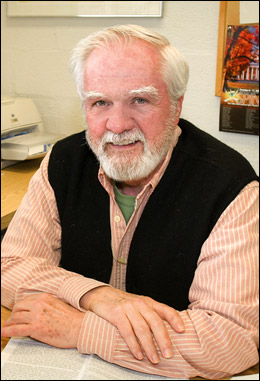T. Laurence Trueman Named Senior Physicist Emeritus
April 29, 2008

Larry Trueman
After a 46-year career at BNL, Larry Trueman of the Physics Department retired on April 1, and, as a scientist who has made significant contributions to the Laboratory, he has been named Senior Physicist Emeritus. With this new title, Trueman will regain the rights and privileges of an employee, and he will continue to pursue his research at the Laboratory on a part-time basis.
"I was one of the original proponents of the Emeritus title," Trueman said. "It's an easier choice to retire if you're given the title, since you're not abruptly cutting your association with a place and a career that you've had for perhaps 40 or 45 years. You can continue your career and your life at BNL."
"As a theoretical physicist, Trueman has made seminal contributions to many of the important developments that have defined Brookhaven's leadership in elementary particle physics from the 1960s to the present day," said Thomas Ludlam, chair of the Physics Department. "These include discoveries in particle spectroscopy and rare kaon decay processes at the Alternating Gradient Synchrotron (AGS), exploration of new phenomena at the energy frontier with high energy colliders, and the physics of spin-polarized particle collisions, both at the AGS and the Relativistic Heavy Ion Collider (RHIC)."
Looking back at his distinguished career at Brookhaven, a thread that goes through much of Trueman's research starts with the discovery of a general relation between scattering amplitudes of spinning particles with his BNL mentor Gian Carlo Wick and goes all the way to his most recent published work on polarized protons at RHIC. He spent much of his career developing and applying the Regge Theory -- a theory in strong interaction physics initiated by Tullio Regge in 1957 -- to particles with spin.
During the last decade, Trueman has worked on descriptions of polarized proton interactions at RHIC, and he developed a method for predicting the absolute polarization of proton beams at RHIC to an accuracy of better than ten percent, a calculation that is important for designing and implementing polarized proton experiments at the collider. In his new Emeritus role, Trueman plans to continue to study proton spin -- a basic property of elementary particles -- relating theory to experiments done by international collaborations at RHIC.
Trueman earned a B.A. in physics from Dartmouth College in 1957 and a Ph.D. in physics from the University of Chicago in 1962. He joined BNL in the same year as a research associate in the Physics Department, moving through the ranks to become a senior physicist in 1974. From 1972 to 1973, Trueman was a Guggenheim Fellow at Oxford University.
After returning to BNL, he became leader of the High Energy Theory Group, a position he held from 1974 to 1981. "One of my proudest achievements was building the BNL High Energy Theory Group into one of the finest in the land," Trueman said.
He then became deputy chair of the Physics Department for a five-year term, returning to research in 1986. During this period he twice became a visiting professor/scientist at the Universite d'Aix-Marseille in the south of France. Trueman was appointed the first associate laboratory director for the combined fields of High Energy and Nuclear Physics, from 1988 to 1991. In this position he continued to push the rare K-decay program that began when he was deputy chair and the newly begun g-2 experiment and the exotic hadron experiment at the AGS. In addition, he made the first call for proposals for experiments at RHIC to prepare for its imminent completion. He then returned to research as a senior physicist working in both heavy ion physics and spin physics.
A Fellow of the American Physical Society, Trueman has been active in mentoring and guiding the careers of young scientists in the Physics Department. He served on the Brookhaven Council from 1993 to 1996, and was chair of the council from 1995 to 1996. He was also a member of the initial RIKEN BNL Research Center Advisory Committee from 1996 to 2000.
2008-617 | INT/EXT | Newsroom









